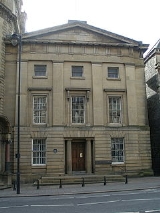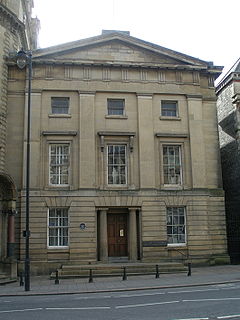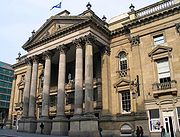
John and Benjamin Green
Encyclopedia
John and Benjamin Green were a father and son who worked in partnership as architect
s in North East England
during the early nineteenth century. John, the father was a civil engineer as well as an architect. Although they did carry out some commissions separately, they were given joint credit for many of their projects, and it is difficult to attribute much of their work to a single individual. In general, John Green worked on civil engineering projects, such as road and rail bridges, whereas Benjamin worked on projects that were more purely architectural.
Drawings by John and Benjamin Green are held by the Laing Art Gallery
in Newcastle upon Tyne.
 John Green was born on 29 June 1787 at Newton Fell House, Nafferton
John Green was born on 29 June 1787 at Newton Fell House, Nafferton
, two miles north of Ovington, Northumberland
. He was the son of Benjamin Green, a carpenter and maker of agricultural implements. After finishing school, he worked in his father’s business. The firm moved to the market town of Corbridge
and began general building work with young John concentrating on architectural work. About 1820, John set up business as an architect and civil engineer in nearby Newcastle
.
John Green married Jane Stobart in 1805, and they had two sons, John (c1807-68) and Benjamin (c1811-58), both of whom became architects. Unfortunately little is known about the career of John, but Benjamin worked in partnership with his father on many projects.
estate near Hexham
and also on the Duke of Northumberland
’s estates. John Green was principally a civil engineer, and built several road and rail bridges. In 1829-31 he built two wrought-iron suspension bridges crossing the Tyne
(at Scotswood) and the Tees (at Whorlton
). The bridge at Scotswood was demolished in 1967 but the one at Whorlton still survives. When the High Level Bridge
at Newcastle was proposed ten years later, John Green submitted plans, but those of Robert Stephenson
were accepted by the York, Newcastle and Berwick Railway. Green also built two masonry bridges for the Newcastle and North Shields Railway, at the Ouseburn
and at Willington Quay
. He also built a number of bridges using an innovative system of laminated timber arches. In 1840 he was elected to the Institution of Civil Engineers
, and in 1841 he was awarded the institution’s Telford Medal
for his work on laminated arch design.

 Benjamin Green was a pupil of Augustus Charles Pugin
Benjamin Green was a pupil of Augustus Charles Pugin
, father of the more famous Augustus Welby Northmore Pugin. In the mid-1830s he became a partner of his father and remained so until the latter’s death in 1852. The two partners differed somewhat. John has been described as a ‘plain, practical, shrewd man of business’ with a ‘plain, severe and economical’ style, whereas Benjamin was ‘an artistic, dashing sort of fellow’, with a style that was ‘ornamental, florid and costly’.
The Greens worked as railway architects and it is believed that the mail line stations between Newcastle and Berwick upon Tweed were designed by Benjamin. They also designed a number of Northumbrian churches, the best examples being at Earsdon
and Cambo
.
The Green’s most important commissions in Newcastle were the Theatre Royal
(1836-7) and the column for Grey's Monument
(1837-8). Both of these structures were part of the re-development of Newcastle city centre in neo-classical style by Richard Grainger
, and both exist today. Although both of the partners were credited with their design, it is believed that Benjamin was the person responsible.
Another well-known structure designed by the Greens is Penshaw Monument
(1844). This is a folly standing on Penshaw
Hill in County Durham. It was built as a half-sized replica of the renowned Temple of Hephaestus
in Athens
, and was dedicated to John George Lambton, first Earl of Durham
and the first Governor
of the Province of Canada
. The monument, being built on a hill is visible for miles around and is a famous local landmark. It is now owned by the National Trust
.
Benjamin Green survived his father by only six years, and died in a mental home at Dinsdale Park
, County Durham on 14 November 1858.
Architect
An architect is a person trained in the planning, design and oversight of the construction of buildings. To practice architecture means to offer or render services in connection with the design and construction of a building, or group of buildings and the space within the site surrounding the...
s in North East England
North East England
North East England is one of the nine official regions of England. It covers Northumberland, County Durham, Tyne and Wear, and Teesside . The only cities in the region are Durham, Newcastle upon Tyne and Sunderland...
during the early nineteenth century. John, the father was a civil engineer as well as an architect. Although they did carry out some commissions separately, they were given joint credit for many of their projects, and it is difficult to attribute much of their work to a single individual. In general, John Green worked on civil engineering projects, such as road and rail bridges, whereas Benjamin worked on projects that were more purely architectural.
Drawings by John and Benjamin Green are held by the Laing Art Gallery
Laing Art Gallery
The Laing Art Gallery in Newcastle upon Tyne, England is located on New Bridge Street. It was opened in 1904 and is now managed by Tyne & Wear Archives & Museums and sponsored by the Department for Culture, Media and Sport. In front of the gallery is the Blue Carpet.The gallery holds oil paintings,...
in Newcastle upon Tyne.
Early life of John Green

Nafferton
Nafferton is a village and civil parish in the East Riding of Yorkshire, England. It is situated approximately north east of Driffield town centre and lies just south of the A614 road....
, two miles north of Ovington, Northumberland
Ovington, Northumberland
The civil parish of Ovington lies in southern Northumberland, on the north bank of the River Tyne. It is one of the smallest parishes in the county.- History :...
. He was the son of Benjamin Green, a carpenter and maker of agricultural implements. After finishing school, he worked in his father’s business. The firm moved to the market town of Corbridge
Corbridge
Corbridge is a village in Northumberland, England, situated west of Newcastle and east of Hexham. Villages in the vicinity include Halton, Acomb, Aydon and Sandhoe.-Roman fort and town:...
and began general building work with young John concentrating on architectural work. About 1820, John set up business as an architect and civil engineer in nearby Newcastle
Newcastle upon Tyne
Newcastle upon Tyne is a city and metropolitan borough of Tyne and Wear, in North East England. Historically a part of Northumberland, it is situated on the north bank of the River Tyne...
.
John Green married Jane Stobart in 1805, and they had two sons, John (c1807-68) and Benjamin (c1811-58), both of whom became architects. Unfortunately little is known about the career of John, but Benjamin worked in partnership with his father on many projects.
John Green’s career
In 1822 John Green designed a new building for the Newcastle Literary and Philosophical Society. The building, which houses the society’s substantial library, is still in use today. He also designed a number of farmhouses, being employed on the BeaufrontBeaufront Castle
Beaufront Castle is a privately owned 19th century country house near Hexham, Northumberland, England. It is a Grade I listed building.A pele tower was recorded at Beaufront in 1415...
estate near Hexham
Hexham
Hexham is a market town and civil parish in Northumberland, England, located south of the River Tyne, and was the administrative centre for the Tynedale district from 1974 to 2009. The three major towns in Tynedale were Hexham, Prudhoe and Haltwhistle, although in terms of population, Prudhoe was...
and also on the Duke of Northumberland
Duke of Northumberland
The Duke of Northumberland is a title in the peerage of Great Britain that has been created several times. Since the third creation in 1766, the title has belonged to the House of Percy , which held the title of Earl of Northumberland from 1377....
’s estates. John Green was principally a civil engineer, and built several road and rail bridges. In 1829-31 he built two wrought-iron suspension bridges crossing the Tyne
River Tyne
The River Tyne is a river in North East England in Great Britain. It is formed by the confluence of two rivers: the North Tyne and the South Tyne. These two rivers converge at Warden Rock near Hexham in Northumberland at a place dubbed 'The Meeting of the Waters'.The North Tyne rises on the...
(at Scotswood) and the Tees (at Whorlton
Whorlton, County Durham
Whorlton is a village in County Durham, in England. It is situated to the east of Barnard Castle,Whorlton is situated near the River Tees. It has a pub called the 'Bridge Inn' due to the 19th century suspension bridge situated just outside the village. Arthur Headlam and James Wycliffe Headlam were...
). The bridge at Scotswood was demolished in 1967 but the one at Whorlton still survives. When the High Level Bridge
High Level Bridge
The High Level Bridge is a road and railway bridge spanning the River Tyne between Newcastle upon Tyne and Gateshead in North East England.-Design:...
at Newcastle was proposed ten years later, John Green submitted plans, but those of Robert Stephenson
Robert Stephenson
Robert Stephenson FRS was an English civil engineer. He was the only son of George Stephenson, the famed locomotive builder and railway engineer; many of the achievements popularly credited to his father were actually the joint efforts of father and son.-Early life :He was born on the 16th of...
were accepted by the York, Newcastle and Berwick Railway. Green also built two masonry bridges for the Newcastle and North Shields Railway, at the Ouseburn
Ouseburn
The Ouseburn is a river which flows through Newcastle upon Tyne into the River Tyne. The river gives its name to the Ouseburn electoral ward....
and at Willington Quay
Willington Quay
Willington Quay is an area in the borough of North Tyneside in Tyne and Wear in northern England. It is situated on the north bank of the River Tyne, facing Jarrow, and between Wallsend and North Shields. It is served by the Howdon Metro station in Howdon. The area from 2006 onwards has been an...
. He also built a number of bridges using an innovative system of laminated timber arches. In 1840 he was elected to the Institution of Civil Engineers
Institution of Civil Engineers
Founded on 2 January 1818, the Institution of Civil Engineers is an independent professional association, based in central London, representing civil engineering. Like its early membership, the majority of its current members are British engineers, but it also has members in more than 150...
, and in 1841 he was awarded the institution’s Telford Medal
Telford Medal
The Telford Medal is the highest prize awarded by the British Institution of Civil Engineers for a paper, or series of papers, in the field of engineering. It was introduced in 1835 following a bequest made by Thomas Telford, the ICE's first president....
for his work on laminated arch design.
Benjamin Green’s career


Augustus Charles Pugin
Augustus Charles Pugin, born Auguste Charles Pugin, was an Anglo-French artist, architectural draughtsman, and writer on medieval architecture...
, father of the more famous Augustus Welby Northmore Pugin. In the mid-1830s he became a partner of his father and remained so until the latter’s death in 1852. The two partners differed somewhat. John has been described as a ‘plain, practical, shrewd man of business’ with a ‘plain, severe and economical’ style, whereas Benjamin was ‘an artistic, dashing sort of fellow’, with a style that was ‘ornamental, florid and costly’.
The Greens worked as railway architects and it is believed that the mail line stations between Newcastle and Berwick upon Tweed were designed by Benjamin. They also designed a number of Northumbrian churches, the best examples being at Earsdon
Earsdon
Earsdon is a historical village in the borough of North Tyneside in the county of Tyne and Wear, England. It sits on the border of Northumberland to which is was historically part of, and is approximately two miles from Whitley Bay....
and Cambo
Cambo
Cambo is a village in Northumberland, England. It is about to the west of the county town of Morpeth at the junction of the B6342 and B6343 roads...
.
The Green’s most important commissions in Newcastle were the Theatre Royal
Theatre Royal, Newcastle
The Theatre Royal is a Grade I listed building situated on Grey Street in Newcastle upon Tyne. It was designed by local architects John and Benjamin Green as part of Richard Grainger's grand design for the centre of Newcastle, and was opened on 20 February 1837 with a performance of The Merchant...
(1836-7) and the column for Grey's Monument
Grey's Monument
Grey's Monument is a Grade I listed monument to Charles Grey, 2nd Earl Grey built in 1838 in the centre of Newcastle upon Tyne, England. It was erected to acclaim Earl Grey for the passing of the Great Reform Act of 1832 and stands at the head of Grey Street. It consists of a statue of Lord Grey...
(1837-8). Both of these structures were part of the re-development of Newcastle city centre in neo-classical style by Richard Grainger
Richard Grainger
Richard Grainger was a builder in Newcastle upon Tyne. He worked together with the architects John Dobson and Thomas Oliver, and with the town clerk, John Clayton, to redevelop the centre of Newcastle in the 19th century...
, and both exist today. Although both of the partners were credited with their design, it is believed that Benjamin was the person responsible.
Another well-known structure designed by the Greens is Penshaw Monument
Penshaw Monument
Penshaw Monument is a folly built in 1844 on Penshaw Hill between the districts of Washington and Houghton-le-Spring, within the City of Sunderland, North East England...
(1844). This is a folly standing on Penshaw
Penshaw
The village of Penshaw , formerly known as Painshaw or Pensher, is an area of the metropolitan district of the City of Sunderland, in Tyne and Wear, England...
Hill in County Durham. It was built as a half-sized replica of the renowned Temple of Hephaestus
Temple of Hephaestus
The Temple of Hephaestus, also known as the Hephaisteion or earlier as the Theseion, is the best-preserved ancient Greek temple; it remains standing largely as built. It is a Doric peripteral temple, and is located at the north-west side of the Agora of Athens, on top of the Agoraios Kolonos hill....
in Athens
Athens
Athens , is the capital and largest city of Greece. Athens dominates the Attica region and is one of the world's oldest cities, as its recorded history spans around 3,400 years. Classical Athens was a powerful city-state...
, and was dedicated to John George Lambton, first Earl of Durham
Earl of Durham
Earl of Durham is a title in the Peerage of the United Kingdom. It was created in 1833 for the prominent Whig politician and colonial official John Lambton, 1st Baron Durham. Known as "Radical Jack", he played a leading role in the passing of the Great Reform Act of 1832...
and the first Governor
Governor
A governor is a governing official, usually the executive of a non-sovereign level of government, ranking under the head of state...
of the Province of Canada
Province of Canada
The Province of Canada, United Province of Canada, or the United Canadas was a British colony in North America from 1841 to 1867. Its formation reflected recommendations made by John Lambton, 1st Earl of Durham in the Report on the Affairs of British North America following the Rebellions of...
. The monument, being built on a hill is visible for miles around and is a famous local landmark. It is now owned by the National Trust
National Trust for Places of Historic Interest or Natural Beauty
The National Trust for Places of Historic Interest or Natural Beauty, usually known as the National Trust, is a conservation organisation in England, Wales and Northern Ireland...
.
Deaths
John Green died in Newcastle on 30 September 1852.Benjamin Green survived his father by only six years, and died in a mental home at Dinsdale Park
Dinsdale Park
Dinsdale Park is a 19th century mansion and former Spa hotel at Low Dinsdale, near Darlington, County Durham, England now converted into residential apartments...
, County Durham on 14 November 1858.

